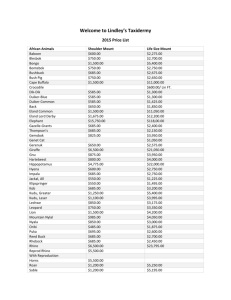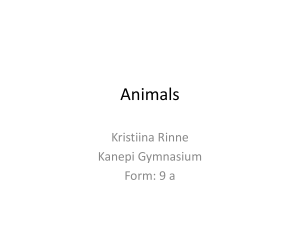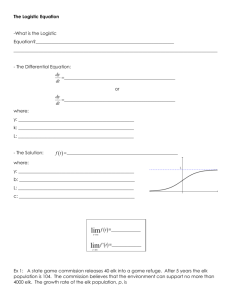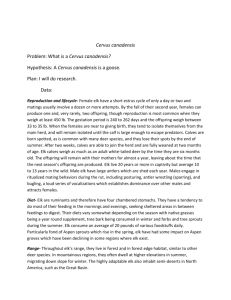Elk Ecology Lesson Plan
advertisement
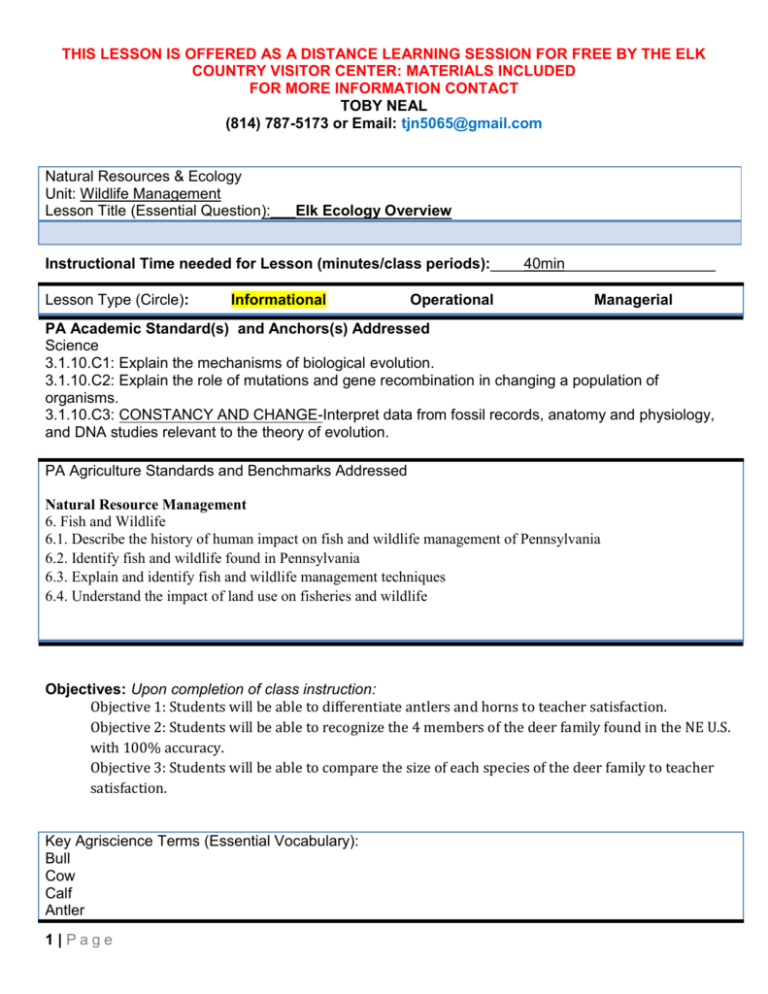
THIS LESSON IS OFFERED AS A DISTANCE LEARNING SESSION FOR FREE BY THE ELK COUNTRY VISITOR CENTER: MATERIALS INCLUDED FOR MORE INFORMATION CONTACT TOBY NEAL (814) 787-5173 or Email: tjn5065@gmail.com Natural Resources & Ecology Unit: Wildlife Management Lesson Title (Essential Question):___Elk Ecology Overview Instructional Time needed for Lesson (minutes/class periods):____40min__________________ Lesson Type (Circle): Informational Operational Managerial PA Academic Standard(s) and Anchors(s) Addressed Science 3.1.10.C1: Explain the mechanisms of biological evolution. 3.1.10.C2: Explain the role of mutations and gene recombination in changing a population of organisms. 3.1.10.C3: CONSTANCY AND CHANGE-Interpret data from fossil records, anatomy and physiology, and DNA studies relevant to the theory of evolution. PA Agriculture Standards and Benchmarks Addressed Natural Resource Management 6. Fish and Wildlife 6.1. Describe the history of human impact on fish and wildlife management of Pennsylvania 6.2. Identify fish and wildlife found in Pennsylvania 6.3. Explain and identify fish and wildlife management techniques 6.4. Understand the impact of land use on fisheries and wildlife Objectives: Upon completion of class instruction: Objective 1: Students will be able to differentiate antlers and horns to teacher satisfaction. Objective 2: Students will be able to recognize the 4 members of the deer family found in the NE U.S. with 100% accuracy. Objective 3: Students will be able to compare the size of each species of the deer family to teacher satisfaction. Key Agriscience Terms (Essential Vocabulary): Bull Cow Calf Antler 1|Page Horn Migratory Ivory Modalities Addressed: x Visual x Auditory Multiple Intelligences Addressed: Logical Verbal-Linguistic x Mathematical xKinesthetic x Naturalist x Visual-Spatial x Bodily-Kinesthetic Musical x Interpersonal Intrapersonal Need/Situation: 250 students, Grade 3 Students will have the opportunity to explore elk ecology through an in depth interactive virtual session. Students will use their senses to learn with the props included in the elk trunk. Resources (Community, etc) ECVC Project WILD Realia (Tools, Equipment and Supplies): Microsoft Surface Elk Pelt Elk Antler Deer Antler Moose Antler Caribou Antler Bison horn Elk Skull with Ivories Back drop Radio-telemetry Collars Deer Fawn and Elk Calf mounts Deer and Elk Track Deer and elk jawbones Deer and Elk Scapulas Pre-Class Set-Up Props on table arranged in front of back drop. Surface camera facing props Bell Work: N/A Interest Approach (Activating Strategies): Virtual Lesson Elk Trunk in Classroom 2|Page Transition/Segue Questions (at least 2-3): What is an antler made out of? What is the difference between a reindeer and caribou? What is a horn made out of? How can you tell an elk’s age? Summary of Content and Teaching Strategies (40min) General Elk Lecture (While discussing the items, you can pass around the objects and have students describe them to you.) Irish Elk Poster- Antlers spread 12ft & Weigh 88-100lbs - Could not get enough nutrition to keep bones healthy - Extinction could be related to gigantism - Osteoporosis-brittle bone disease Prehistoric Elk Poster (Fangs) - Used for defense - Could have eaten small mammals and been omnivores - Modern Elk Ivories are remnants of these “tusks” - Modern musk deer in Asia still have these protrusions European Red Deer Poster - Crossed Bearing Straight Land Bridge - Stranded in North America - Developed into the Modern sub-species of elk - Adapted/changed to live in the habitat they were in - North America has a large variety of habitats Elk Sub-species Posters - Merriam Elk- Extinct, Lived in Parts of TX, OK, and New Mexico - Eastern Woodland Elk- Extinct, lived here in PA, and East of the Mississippi, Last one shot in 1867 - Manitoba Elk- Alive and Well, Province VS State, found in the Province of Manitoba, Canada, some filter into Northern US - Tule Elk- Alive and Well, Lives in the deserts of California & Arizona, Smallest Sub- Species, Nickname-Camel Elk, lives a long time without water - Roosevelt Elk- Alive and Well, Largest Sub-species, Nickname- Ghost of the Forest. Dark coloration/camo, Lives in the TEMPERATE Rain Forest of Washington and Oregon - Rocky Mountain Elk- Alive and Well, Original elk came from Colorado and Wyoming, Now the Species we have in PA, Trapped and traveled by train and released into PA Comparison among Deer Family (Elk, Moose, White-tail Deer, Caribou) - Moose- Largest, Antlers used to assist in feeding 3|Page - Elk- Second Largest - Caribou- Next to Smallest, both males and females have antlers - White-tailed Deer- Smallest, Browsers Size Comparison White-tail Deer vs. Elk (Babies, tracks, scapulas, jaw bones, antlers) - Elk Calves Born around 40lbs VS White-tailed Deer around 7lbs - Tracks- Elk- Size of Cattle VS Deer- size of goats - Scapulas- both used as Native American weapons, today artwork - Jaw bones- Elk- Grazers VS Deer-Browsers - Antlers- Cannot age by antler size, depends on nutrition, genetics, and age Antlers vs. Horns - Antlers=Bone VS Horns=Keratin - Antlers= Many Points VS Horns=single point - Antlers=Regrowth VS Horns=permanent (1 exception= Pronghorn Antelope have horns that shed) Population and Research -Radio collars - Minimum number alive -Aerial Surveys Extras: Oh Deer (Project WILD) 4|Page
